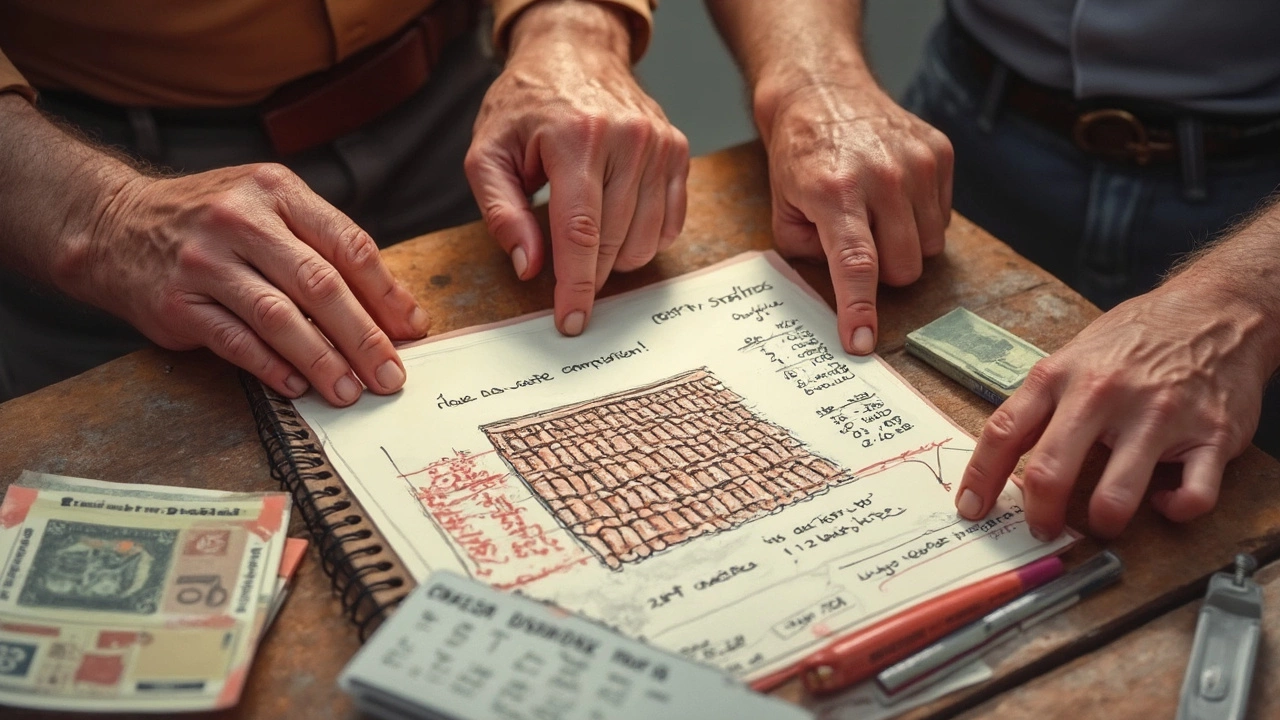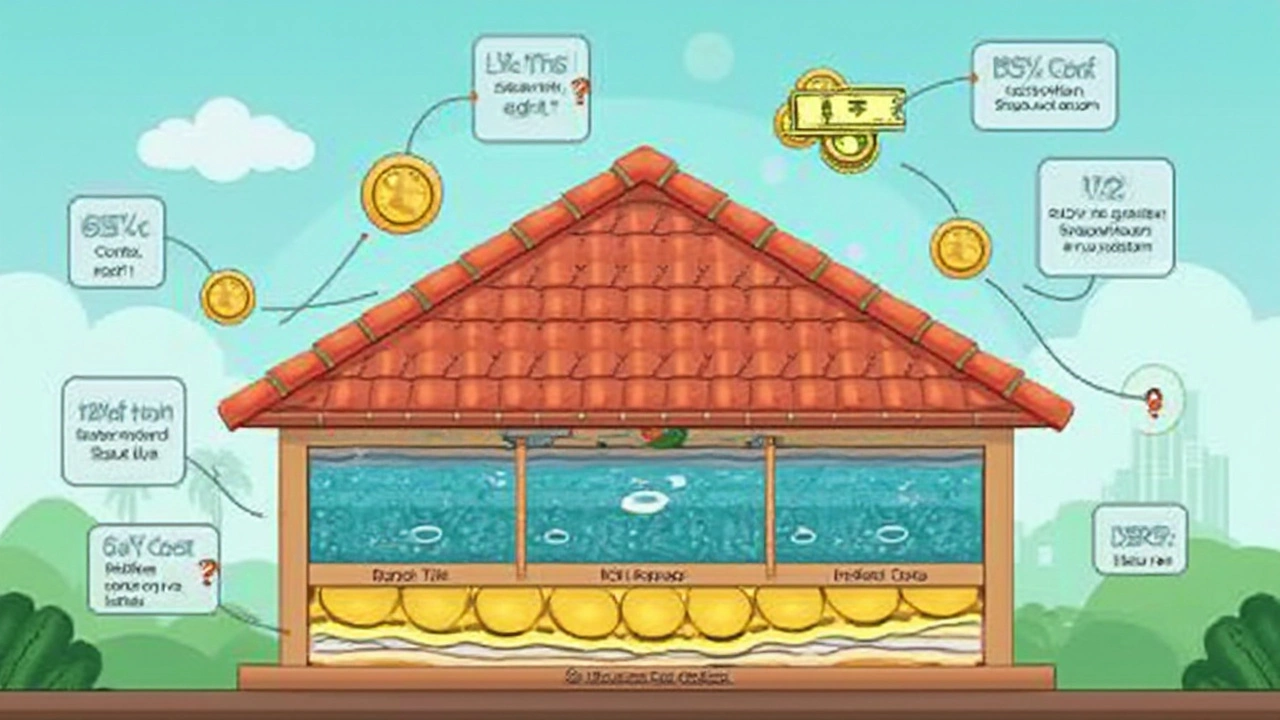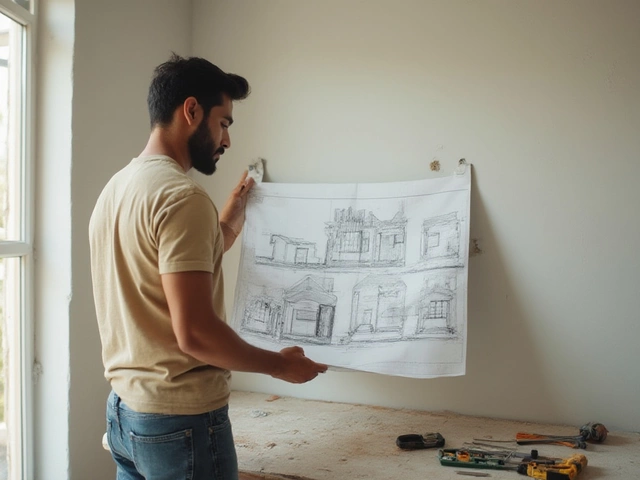If the idea of budgeting for a roof gives you a headache, you're not alone. Roofs aren’t something folks replace often, so it’s not obvious what it all costs. The price tag can swing a lot—even between houses on the same street—so just grabbing a number off Google doesn’t really cut it. Miss something, and you might drain your savings faster than you planned.
First off, you need to know if you’re looking at a quick fix or a full-on replacement. Sometimes a leak just needs a patch, but other times, water damage or age means the whole thing’s got to go. Don’t pay for more than you need—get up there or hire someone to truly check. Snap clear photos, look for missing shingles, soft spots, granules in the gutters, or weird dips. Even if you aren’t a pro, a local roofing company will often give a free or cheap inspection so you’ll know what you’re really dealing with before you start crunching numbers.
- Figuring Out What Your Roof Really Needs
- The Real Numbers: Breaking Down Roofing Costs
- Getting Quotes and Comparing Contractors
- Tips to Save Money Without Cutting Corners
- Preparing for Surprises and Extra Costs
Figuring Out What Your Roof Really Needs
The first step in roof budgeting is figuring out what actually needs fixing. Is it just a couple of cracked shingles messing things up, or is the whole thing sagging and past its prime? Being honest here can save you thousands down the road.
Roofs have life spans, and most asphalt shingle roofs last about 20-25 years. Metal and tile can push 40 years or more, but age isn't everything. Stuff like severe storms, tree limbs, and even lousy ventilation can cut years off. About 70% of roof projects in the U.S. are full replacements because folks wait too long or patch over bigger issues.
Here’s what to look for during your checkup:
- Curled, cracked, or missing shingles—major sign it’s time for something more than a patch.
- Dark streaks, moss, or strange stains—that’s often a sign water’s seeping in.
- Granules in gutters—it means the shingles are breaking down.
- Soft, spongy spots—grab a buddy and walk the roof (carefully), feeling for spots that give. Might be rotten decking underneath.
- Daylight coming in your attic? That’s a neon sign for leaks.
Having clear photos and a punch list of issues makes it way easier to get honest quotes. If you’re not comfortable climbing up there, call a trusted roofing pro. Many will check things out and give you a written report for free or a small fee.
Here’s a snapshot of how long roofs last, on average:
| Material | Average Lifespan (Years) |
|---|---|
| Asphalt Shingle | 20 - 25 |
| Metal | 40 - 70 |
| Tile | 50 + |
| Wood Shake | 20 - 40 |
Sometimes what seems like a big problem is just a minor repair. Other times, putting off a full replacement leads to busted drywall, mold, or ruined insulation. When you know exactly what your roof needs, every move you make next—every quote, every roof budgeting decision—will be sharper and safer for your wallet.
The Real Numbers: Breaking Down Roofing Costs
Let’s not dance around it—roofs get expensive, fast. Most U.S. homeowners spend between $6,000 and $14,000 for a new asphalt shingle roof on an average-sized home. If you want metal, tile, or slate, prices can shoot way past $20,000. The square footage of your roof, material choice, and how steep or complex your roof is will swing your final tab more than you might expect.
Here’s how the basic numbers shake out:
- Roof budgeting really starts with size. Roofing is priced by the “square”—that’s 100 square feet. So if your roof is 2,000 square feet, you’re looking at 20 “squares.”
- Asphalt shingles (the most common option) usually run $350 to $700 per square, installed. Metal goes from $800 to $1,500 per square. Tile and slate can start at $1,200 and climb from there.
- Labor is a big chunk—sometimes up to 60% of the cost. Roofers in big cities usually charge more than those in rural spots, and if your roof’s steep or complicated, expect a labor upcharge.
- Dump fees for tearing off the old roof can add a few hundred dollars. Don’t forget those! You might also need to pay for permits, which can run from $100 to $500 depending on your city.
- Sometimes, the plywood under your shingles is rotten or damaged. If the crew needs to replace that “decking,” it’s usually $2 to $6 per square foot—so that can add up fast.
Budget for at least 10% extra on whatever number you get, just in case something’s hiding under your old shingles. And remember, any upgrades—like better underlayment or designer shingles—will add to your total. Always ask for itemized estimates, so you know exactly where your money’s going.

Getting Quotes and Comparing Contractors
This is where it pays to do your homework. The difference in roofing quotes can be thousands of dollars, even for the same job. Don’t just call one place and hope they’re the best. Aim for at least three quotes from different contractors. When you contact them, make sure you’re asking for the same thing each time or you’ll have apples-to-oranges bids that make comparing impossible.
Ask for a detailed written estimate. That should break down the cost of materials, labor, permits, and cleanup. Watch out for anyone who only gives you a lump sum without details. If you want to see what a typical breakdown looks like, here’s a sample from last year’s averages in the U.S. for a 2,000-square-foot asphalt shingle roof:
| Item | Average Cost (USD) |
|---|---|
| Materials | $5,000 - $7,000 |
| Labor | $3,000 - $5,000 |
| Permits and Fees | $250 - $500 |
| Dump Fees / Cleanup | $400 - $600 |
Some contractors toss in warranties or offer financing, so pay attention to extras that might be wrapped in. Ask how long the job will take, and if they’re using subcontractors or their own crew.
- Check their licenses and insurance—don’t just take their word. Ask to see the paperwork up front.
- Look up their reviews. Real experiences on places like Google or the Better Business Bureau can show if they’re reliable or a pain to deal with.
- Ask for addresses of recent jobs so you can drive by and see their work. Some folks knock on doors to chat with past clients—don’t be shy.
- Find out how they’ll handle weather delays or surprises. A professional should walk you through backup plans.
The lowest price can be tempting, but don’t let it blind you. Roofers who cut their price way down might skip on quality or cut corners you’ll regret. Stick with someone who offers clear info, answers your questions, and puts everything in writing. It pays off big time in the long run for your roof budgeting and peace of mind.
Tips to Save Money Without Cutting Corners
No one wants to throw thousands of bucks at a roof if they don’t have to. But skimping on quality or ignoring good prep can end up costing more in the long run. Here’s how to keep your roof budgeting in check without risking leaks down the road.
- Shop Around Smartly: Don’t just take the first quote. Get estimates from at least three local roofing companies. This isn’t just about finding the lowest price—it’s about figuring out what’s fair for your roof’s size and style. Companies should break down labor, materials, and extras in detail.
- Choose Materials Wisely: Architectural shingles usually last longer than basic 3-tab styles, and they aren’t always a lot more expensive. Metal roofs have higher upfront costs but can last 40-70 years and may lower home insurance. Ask for price options and think long-term.
- Time It Right: Roofing is busiest in late summer and fall. During slower seasons (like late winter or early spring, depending on where you live), contractors may offer discounts.
- Reuse What You Can: If the decking (the wood under your shingles) is still solid, you probably don’t need a full tear-off. Ask if you can install the new roof over the old one—it’s allowed in some areas, but not always a good idea if there’s water damage or more than one old layer.
- Handle Minor Work Yourself: Stuff like trimming overhanging branches, clearing gutters, or removing old satellite dishes is easy if you’re handy. Less for the crew to do means less for you to pay for.
- Use Insurance or Financing: If the damage is storm-related, homeowners insurance might cover the bill. Check your policy and talk to your agent. Many roofers have financing plans if you can’t pay all at once—but watch out for high interest rates.
| Material | Average Cost/Sq. Ft. | Average Lifespan |
|---|---|---|
| 3-tab asphalt shingles | $3.50–$5.50 | 12–20 years |
| Architectural shingles | $5.00–$7.50 | 20–30 years |
| Metal roofing | $8.00–$14.00 | 40–70 years |
Don’t fall for a contractor who pressures you with "today only" deals or asks for a huge deposit upfront. Legit roofing crews rarely need more than 10-15% to get started. And read the fine print in your warranty—the cheapest jobs might leave you on the hook for repairs later. Spend a little time upfront, and you’ll save a lot more on the back end.

Preparing for Surprises and Extra Costs
No matter how good your plan is, stuff pops up when dealing with roof budgeting. A lot of homeowners end up spending 10-20% more than they expected. Why? Because you just can’t see every single problem until the old roof’s ripped off. There could be hidden wood rot, extra layers, bad flashing, or even lousy work from the last contractor. These aren’t rare; they’re pretty common.
One smart move: build a buffer into your budget. Most roofing pros (and experienced homeowners) recommend setting aside an extra 15% on top of what you plan to spend. For example, if your roof quote is $11,000, stash $1,650 just in case. This emergency fund keeps you from scrambling for cash or trying to cut corners later.
Here’s a look at common surprise costs, with real price ranges:
| Surprise Issue | Estimated Cost (per job) |
|---|---|
| Replacing rotten plywood | $60-$100 per sheet |
| Fixing damaged rafters | $500-$1,000+ |
| Bringing roof up to current code | $500-$2,000 |
| Removing extra old roof layers | $1,000-$2,500 |
| Upgrading flashing/chimney repairs | $300-$1,200 |
| Waste and debris disposal | $300-$800 |
Also, double-check whether your quote includes things like ventilation, permit fees, and cleanup. Some crews bury those costs or leave them as surprise add-ons. Ask for everything in writing, make sure warranty info is clear, and don’t be afraid to ask blunt questions about what could go wrong or what costs extra.
- Get a written scope that lists everything covered.
- Ask for labor and materials guarantees in the contract.
- Request a line-item breakdown in your bid—if it’s all lumped together, that’s a red flag.
- Find out who covers unexpected repairs—sometimes insurance helps, sometimes it doesn’t.
Planning for these surprises means you won't feel blindsided or forced into a rushed decision. That peace of mind is worth way more than what you spend on stain-proof paint or fancy gutter guards.




Write a comment